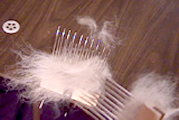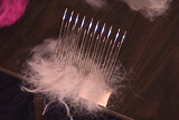This method of fiber preparation is suitable for preparing double coated fibers for spinning. Combing the fiber separates the shorter fibers from the longer ones. The short fibers are left behind in the stationary comb, and can be carded into rolags. The long fibers are formed into a sliver or a combed top by using a diz.
During the combing process, the fibers are kept parallel. Combed fiber is preferred for spinning worsted yarn using the worsted technique or spinning from the fold.
 Set up
Set up
Clamp the stationary comb onto a table top. Take a lock of wool and lash it onto the tines. Flip the locks so that the butt ends catch the tines. Fill the whole width of the comb. Bring two or three more rows of locks until about halfway up the tines.
 Combing
Combing
Comb with the hand comb In horizontal position from the right to the left. Enter the tips of the wool with the tines of the hand comb, so that the wool flips over the head of the comb where it won’t tangle on subsequent strokes.
You will notice that almost all the wool is being transferred to the hand comb. Most of it will fluff out but some will still be clumped together at this stage. After completing the first pass, the stationary comb will hold only second cuts and trash, which should be removed.

Comb the wool back onto the stationary comb by moving the filled hand comb in horizontal position from the top to the bottom along the pointing up tines of the stationary comb. Repeat this move until all of the wool comes back on the stationary comb. Make two or more combing passes till the wool is smooth and aligned. As before, the shorter flbers will remain in the comb, while the longer fibers will transfer.
Making a Sliver
All the wool has to be on the stationary comb, when you start to pull a sliver. Gently stroke all the wool to a point, pinch the end and pull the wool from the comb. You also can spin straight off the combs by drawing the fibers from the loaded comb. – Louet


